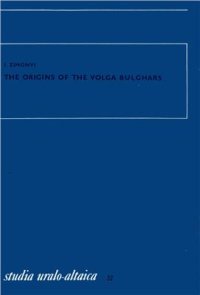
Ebook: The origins of the Volga Bulghars
Author: Zimonyi I.
Szeged: Universitas Szegediensis de Attila József Nominata, 1990. — 211 pp. — (Studia Uralo-Altaica; 32).Muqtadir Billah, the caliph of the Muslim Empire at the beginning of the 10th century, received an ambassador of an unknown ruler from the far north who asked him instructions on religion and Islamic laws. The caliph, understanding the importance of Islamic penetration into Eastern Europe which had been temporary before, sent an embassy from Baghdad in
921. It reached the Samanid court in Transoxania. It travelled from Bukhara to Khwarizm. Finally, only five members of the embassy crossed the Kazak steppe and arrived at the Volga-Kama region in
922. One of these Muslims was Ibn Fadlan who wrote a report about the journey, the countries, and the peoples the embassy had visited. His most detailed account is about the country which he called Saqaliba whose king wanted his people to convert to Islam. This country is known as Bulghar in other Muslim sources and as Volga Bulgharia in later Russian annals to distinguish it from the Danubian Bulgharia. Ibn Fadlan described the political and economical life of the Volga Bulghars, their customs, and the marvels of this northern country. He stated that the Volga Bulghars had been under Khazar supremacy and the king of the Volga Bulghars had embraced Islam in order to counterbalance his political dependence on the Khazar ruler. The glosses in Ibn Fadlan's work concerning the language of the Volga Bulghars reflect Turkic speaking tribes. These tribes were nomads. These latter characteristics provide a basis to suppose that the Volga Bulghars were not autochthons in this region. There are two aims of this paper. The first is to answer the question of where the tribes forming the Volga Bulghars Empire came from. The second is to determine the time of their migration to the Volga-Kama region.
921. It reached the Samanid court in Transoxania. It travelled from Bukhara to Khwarizm. Finally, only five members of the embassy crossed the Kazak steppe and arrived at the Volga-Kama region in
922. One of these Muslims was Ibn Fadlan who wrote a report about the journey, the countries, and the peoples the embassy had visited. His most detailed account is about the country which he called Saqaliba whose king wanted his people to convert to Islam. This country is known as Bulghar in other Muslim sources and as Volga Bulgharia in later Russian annals to distinguish it from the Danubian Bulgharia. Ibn Fadlan described the political and economical life of the Volga Bulghars, their customs, and the marvels of this northern country. He stated that the Volga Bulghars had been under Khazar supremacy and the king of the Volga Bulghars had embraced Islam in order to counterbalance his political dependence on the Khazar ruler. The glosses in Ibn Fadlan's work concerning the language of the Volga Bulghars reflect Turkic speaking tribes. These tribes were nomads. These latter characteristics provide a basis to suppose that the Volga Bulghars were not autochthons in this region. There are two aims of this paper. The first is to answer the question of where the tribes forming the Volga Bulghars Empire came from. The second is to determine the time of their migration to the Volga-Kama region.
Download the book The origins of the Volga Bulghars for free or read online
Continue reading on any device:

Last viewed books
Related books
{related-news}
Comments (0)